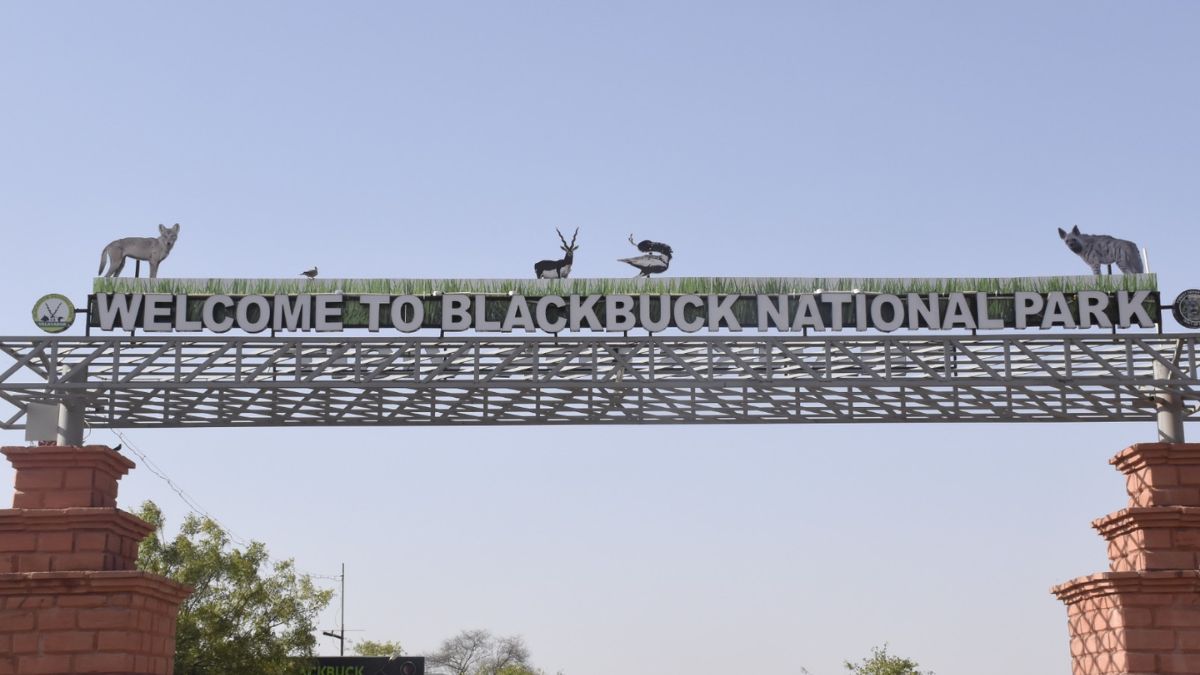Velavadar Blackbuck National Park: A Wildlife Haven in Gujarat
In addition to Blackbucks, the wetlands here are home to wolves, otters, nilgai, and a variety of bird species from both India and abroad.

Advertisement
Bhavnagar, Gujarat : Velavadar Blackbuck National Park, one of Gujarat’s four national parks, is situated 52 km from the city of Bhavnagar. This national park stands out as a remarkable feature of the whole state. In addition to Blackbucks, the wetlands here are home to wolves, otters, nilgai, and a variety of bird species from both India and abroad. Blackbuck Park, home to approximately 5,000 blackbucks, serves as a haven for nature enthusiasts, showcasing animals roaming freely within this national park.
 This national park, featuring its lush grassy areas and habitats filled with native trees, serves as a haven for various wildlife, including blackbuck, nilgai, Indian wolves, otters, foxes, langurs, and migratory birds such as the Khadmor (Laser Florican) and Harriers. This whole region is referred to as “Bhal”. The Bhal area is now officially recognized as Blackbuck National Park. The area of this national park encompasses 34.53 square kilometers. The expansive terrain, parched vegetation, and roaming deer consistently draw in guests to this park. This area features a distinctive grassland ecosystem.
This national park, featuring its lush grassy areas and habitats filled with native trees, serves as a haven for various wildlife, including blackbuck, nilgai, Indian wolves, otters, foxes, langurs, and migratory birds such as the Khadmor (Laser Florican) and Harriers. This whole region is referred to as “Bhal”. The Bhal area is now officially recognized as Blackbuck National Park. The area of this national park encompasses 34.53 square kilometers. The expansive terrain, parched vegetation, and roaming deer consistently draw in guests to this park. This area features a distinctive grassland ecosystem.
Blackbuck
The blackbuck located in Velavadar, Bhavnagar district, is scientifically referred to as “Antelope cervicapra rajputanae,” exhibiting a unique body structure compared to blackbucks in other regions of India. This remarkable creature is known to travel in groups and holds the distinction of being the sole animal capable of covering extensive distances at an impressive speed of 80 km per hour. The leopard stands out as the sole creature capable of sprinting at an impressive 80 km per hour over extended distances, though it can achieve even greater speeds in short bursts. The Blackbuck, when sprinting at its peak, can achieve a maximum distance of 6.60 m between its two hooves.
Khadmor (Laser Florican):
The Lesser Florican, a rare member of the bustard family, is also referred to as Khadmor. Each year, these birds make their appearance following the retreat of the monsoon clouds. The male establishes its territory and draws the female in by producing a whistle that reaches heights of 1.5 to 2.0 meters, accompanied by a distinct thumping sound. This bird can be observed in the national park until the end of September. The female constructs a nest on the ground, where she lays three to four eggs and nurtures the chicks. Investigations are underway regarding its habitat during the non-mating season. The national park is currently closed to tourists, making it impossible to spot these birds at this time.
In this national park, a total of four species of the migratory bird of prey, the falcon, have been documented. These birds migrate from frigid areas such as Kazakhstan and Siberia to winter in this region, having journeyed approximately 8000 km. They consume a variety of food sources including insects, small rodents, birds, caterpillars, and lizards. Falcons from various regions and species gather together at night on the grassy ground, forming what is referred to as a collective roost. This national park is home to the falcon, the buff-faced falcon, the northern falcon, and the leaf falcon.
The jackal, a member of the canine family, is recognized for its scavenging habits. This creature consumes the flesh and skeletal remains of deceased animals for sustenance. It is bigger than an average dog and has a greater height at the front legs, while the back legs are shorter, giving it an unappealing appearance. Distinctive black stripes are observed on its body. These creatures play a crucial role in preserving the ecosystem of the national park, efficiently cleaning up by breaking down large bones of deceased animals and recycling essential nutrients such as calcium and phosphorus.
Indian Wolf:
Blackbuck National Park is renowned for its notable population of Indian wolves. The wolf stands as the apex predator in this environment, with 80 to 90 percent of its diet consisting of black, alongside other food sources such as squirrels, rabbits, and waterfowl. Wolves are social creatures that thrive in packs. The number of members in a group can range from two to thirteen. The young wolves venture into distinct territories as they grow older.
The park remains accessible throughout the year, but the period from mid-June to the end of March is particularly recommended for visits. The ideal period for a visit is from December to March, when numerous migratory birds arrive in the area. Three species of parrots, Lesser Florican, eagles, storks, and various water birds make this place their winter home.
Many facilities have been established here for visitors to Blackbuck National Park. Visitors can purchase tickets for entry into Blackbuck National Park. The cost is significantly less compared to other national parks. Approximately 15 vehicles have been organized for visitors, and there are around 22 guides available to assist them. The natural wetland area here boasts remarkable richness.
Advertisement

